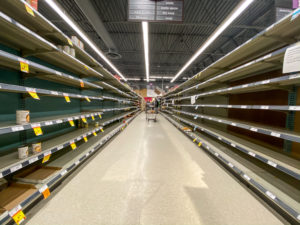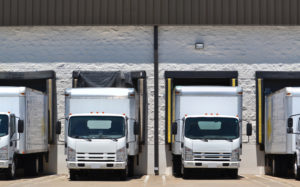
How AI Is Helping the Supply Chain Cope With COVID-19

(Steeve-Raye/Shutterstock)
COVID-19 is wreaking havoc on the American supply chain as companies scramble to respond to rapidly shifting consumer demand, limited supply of some products, and new workplace rules. It’s a lousy time to embark upon a new supply chain optimization project using AI at the moment, but for organizations that already have it in place, AI is paying dividends.
For a look at how the COVID-19 pandemic is impacting $635-billion U.S. consumer goods supply chain, we chatted with Bill Waid, the general manager of decision management with FICO, which provides supply chain planning solutions for some of the country’s biggest manufacturers, distributors, and retailers.
Nobody in the consumer goods supply chain has escaped the impact of COVID-19, Waid says. Even the most sophisticated companies running the latest AI-based modeling technology from FICO and other providers have been forced to override the computer-generated predictions that determine which products, and in what quantities, are delivered where.
“The norms are gone,” Waid tells Datanami. “Whatever was considered the way you approached your supply chain and how you actually met it–all those rules went out the door when this hit. Demand is going up and down and supplies are short in many areas while there are gluts in others.”
Companies that rely entirely on manual methods to plan their supply chain activities, or used rudimentary ones like Excel, are just trying to stay alive at the moment. “For those who were not prepared for this, it’s all hands on deck,” Waid says. “They’re not even considering what to do from a streamlining perspective. Whereas those who are prepared, they have in place the ability to simulate alternative outcomes and very quickly respond.”
No amount of computerized modeling can accurately account for the wild swings in supply and demand that we’re seeing at the moment. Even companies with sophisticated supply chain operations, like Procter and Gamble, the largest manufacturer of toilet paper in the country, are scrambling at the moment.
P&G, which uses FICO’s supply chain modeling software, is capable of responding to rapid shifts in the market. But the scope of the supply chain disruptions due to COVID-19 – specifically around skyrocketing demand for toilet paper – require human intervention, Waid says.
“What was normally modeled in their supply chain [for toilet paper] was just completely disrupted. They required overrides and overrules,” Waid says. “They said, ‘Okay we’re not going to be able to fulfill on toilet paper. If we put that aside, what can we fulfill on, and how do we actually keep the operations going.’”
AI Yields Agility
In a typical implementation, a FICO customer will build many different models to simulate various aspects of their supply chain. Individual models are created and updated for a wide range of uses, from predicting demand for each SKU (stock keeping unit) for each store and route planning, to predicting possible supply shortages and even predicating the rate of absenteeism of the workforce.
Companies that have already built models and had a good handle on baseline demands are better able to respond to sudden disruptions in supply or demand, like the one we’re currently experiencing due to COVID-19.
“Agility is the key here–the agility to quickly respond to those ever-changing mixes of supply and demand, as well as their ability to actually add staff to deliver, which is another interesting dimension to the supply chain that we’re seeing as well,” Waid says. “If they have the agility built in, if they spent time building predictive and prescriptive models to assess this, they’re coping. But coping is probably the best word we can use here.”
To deal with supply chain disruptions caused by COVID-19, companies are tweaking their models to reflect new priorities and new constraints, Waid says.
For example, during normal operations, companies typically configure their models to fulfill all orders as the main priority, with variables like the timeliness of delivery, distance driven during delivery, and profit being secondary factors. But with items like toilet paper flying off the shelves, all orders cannot be fulfilled, so the delivery models need to be modified accordingly.
“Everybody has demand for certain products and you need to balance that across an even distribution,” Waid says. “But then you also have the facility location, how do you route from, how do you route to, and what are your distribution capabilities? You need to be able to very quickly simulate multiple options and assess those scenarios side by side and come up with the most optimal outcome you can get.”
Thousands of Models Daily
Companies that modeled their operations are responding pretty well to the COVID-19 disruptions. Waid says his FICO clients are running hundreds or thousands of simulations with different scenarios every day, which enables them to deliver the best possible fulfillment levels to their downstream clients.
“They don’t actually have to tweak the models. All of our simulation environments and the supporting models underneath them are designed to have inputs from the business,” Waid says. “So the business literally has a dashboard that reflects their operation. They just change dials, cut off limits. They define scenarios that they want to investigate based upon their current supply and demand. They run their full bill of material and route, and come back and get the results of the scenario. They’ll do that literally hundreds or thousands of time, and compare each of those and pick the best one based on what the current situation is at that point in time.”
From a distribution perspective, many companies are eliminating distance driven as a consideration in their models as they seek to minimize outstanding deliveries. The lack of traffic on the roads is helping trucks to move faster between stops on their routes, and even the Federal Government has chipped in by relaxing rules governing how long drivers can work.
On the other hand, some facilities are refusing to unload deliveries at their locations over COVID-19 fears, which requires more labor on the part of the company making the delivery. These are some of the new factors that are going into supply chain models.
Those outfits that already have AI are adapting to the changes, while those without it are struggling, Waid says.
“When you’re dealing with a situation like this, where information is changing constantly, machine learning models are very useful… It can very quickly crunch those number and make very informed estimates of what the forecast patterns are looking like,” Waid says. “If they’re trying to figure that out now, they’re in a bad spot, because they can’t. They’re not spending time building new models at this point in time. They don’t’ have the resource or the focus to do that.
Related Items:
Three Ways AI is Shaping the Supply Chain
A Race Against Time to Model COVID-19





























